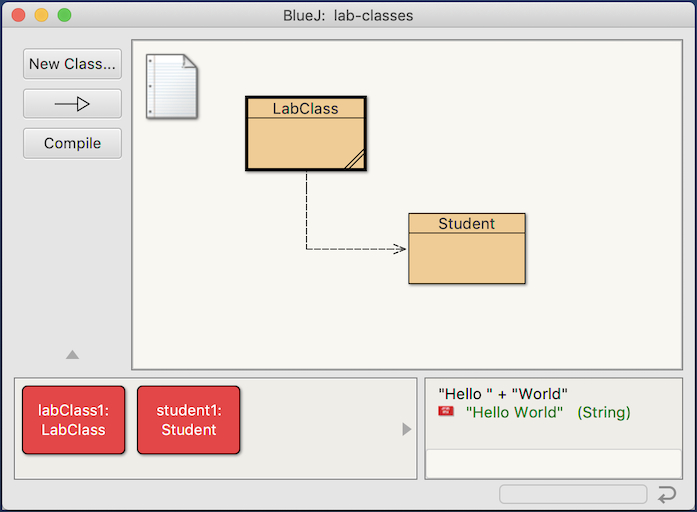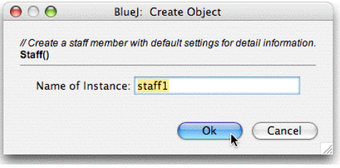Download BlueJ from the BlueJ project website. For detailed instructions how to install BlueJ have a look at the BlueJ installation instructions. LeJOS can be downloaded from the project homepage. For Windows get the bundled installer (leJOSNXJwin32setup.exe) and simply follow the steps of the. Download the latest version of BlueJ for Mac - Java environment designed for introductory teaching. Read 4 user reviews of BlueJ on MacUpdate. BlueJ is an integrated Java environment specifically designed for introductory teaching. Last update 25 Nov. 2010 Licence Free OS Support Mac Downloads Total: 3,323 Last week: 1 Ranking #5 in Components & Libraries Publisher. Users rating: 1.
BlueJ for Mac, free and safe download. BlueJ latest version: Excellent teach yourself Java environment for students. Oct 31, 2020 BlueJ 4.0 for Mac is available as a free download on our software library. This free Mac app was originally developed by Neil Brown, Michael Kolling, Davin McCall, Philip Stevens, John Rosenberg, Ian Utting, Marion Zalk. The application lies within Developer Tools, more precisely IDE. This program's bundle is identified as org.bluej.BlueJ.
Step 3: Installation
Windows:
Double-click the install file (bluej-309.msi).
This will run a standard installation. Follow the instructions on screen. The installer will install the executable bluej.exe. Execute this to run BlueJ.
When executing BlueJ you might get dialog from the firewall asking you whether you want to block or unblock BlueJ; we recommend that you choose not to block BlueJ.
If you have more than one Java version installed, BlueJ will let you select your preferred version the first time it is executed. This can be changed later by running the 'Select BlueJ VM' utility from the Start menu.
Macintosh:
Note: BlueJ 3.0+ requires Java 6. Updating to the latest Java version (via the Mac OS Software Update feature) is recommended. BlueJ 3.0.9 and later also has a package which bundles Java 7, and does not require Java to be installed separately.
Download and expand the install file (BlueJ-309.zip). Move the resulting folder to your preferred location (for example Applications).
Debian, Ubuntu, and other Debian-based systems
Check your distribution's instructions on how to install 'deb' packages. In many cases it will be as simple as double-clicking the downloaded file from within a file manager, and then providing an administrator password to allow the installation to proceed.
Note the 'deb' package requires one of the following packages to be installed:
sun-java6-jdk or openjdk-6-jdk or sun-java7-jdk or openjdk-7-jdk
Installing BlueJ will normally cause an appropriate JDK to be installed.
Please note, the example projects will be installed under /usr/share/doc/BlueJ/
Thanks to Joe Lewis for providing the initial version of the .deb package.
Unix:
Make sure you have a suitable JDK. The Oracle JDK is recommended as it is the most tested. Currently the 'gij' (GNU java interpreter) cannot be used.
Run the installer by executing (from the command shell)
- /path/to/jdk/bin/java -jar bluej-309.jar
... where '/path/to/jdk' should be replaced by the actual path to the JDK.
Note: if you have a suitable java binary in a directory listed in your PATH environment variable, you may be able to omit the '/path/to/jdk' above. Be careful that this does not run an incompatible java implementation (such as 'gij') however! You can check if a Java implementation is in your path by runng 'java -version'.
In the installer, select an installation directory and your JDK directory and install. By default, the installer will install into a directory called 'bluej' inside the directory from which you launch it, and it will pick up the JDK location automatically (if it is run correctly according to the instructions above).
In the directory where BlueJ was installed, you will find a file named bluej. This is the launcher script. Execute this script to start BlueJ. For example:
Note: This installer can be executed on any system with Java installed (including Windows and MacOS), but Windows/MacOS specific icons and configurations will not be present.
Optional: Remove the Installer
If you do not want to make further installations, you can now delete the installer file.
Step 4: Opening a project
After starting BlueJ, open a project by selecting 'Open' from the Project menu. You can find some examples in the 'examples' directory. After the project has been opened, right-clicking (Mac: control-clicking) a class lets you select a constructor from a pop-up menu to construct an object.
Optional: Subscribe to mailing list
If you want to be notified of new releases, go to bluej-announce and subscribe.
If you are interested in general discussion of BlueJ-related questions, read or subscribe to bluej-discuss. There is also an archive of past messages that you can read without subscribing.
Where to from here?

If you have any trouble with the installation, please read How to ask for help.
If it all works this far, you might like to start reading the Tutorial.
BlueJ is a free Java environment available from http://bluej.org. BlueJ is written in Java and runs onany platform with a Java 2 runtime, such as Linux, Solaris,Windows, or Mac OS X. BlueJ requires a Java 2 runtime, so you needto install the Java SDK first before installing BlueJ. You candownload the SDK from http://java.sun.com/j2se/.
BlueJ is a wonderful environment that makes you think about objectsand object-oriented programming. It also contains a simpledebugger.
Starting BlueJ
In BlueJ, you should have a subdirectory for each program.
To start BlueJ, open a command shell and type a command such as
On Linux/Unix, enter a command such as
The details depend on your software installation. In some cases, youmay be able to click on an icon to launch BlueJ.
Loading an existing program
If you already have your program in a Java file (or a directorycontaining multiple Java files), then you need to make a project that contains the file.Follow these steps.
Select Project->Open Non BlueJfrom the menu.In the file dialog, select the directorycontaining your Java files. Do notselect the individual files. For example, the following dialog selectsthe bank directory.
Click on the Open in BlueJbutton.
Now you see the class or classes that BlueJ discovered in theselected subdirectory.
Click the 'Compile' button to compile all classes.
Investigating Objects
The biggest difference between BlueJ and traditional developmentenvironments is that BlueJ isn't concerned with running programs.Instead, you investigate objects.
Click on a class rectangle with the right mouse button. You see all ofits constructors and static methods.Bluejava
To instantiate an object, select an appropriate constructor. Givethe object a name and specify any construction parameters.NOTE: When supplying stringparameters, remember to type in the '...'!
The object is created on the 'object workbench' below theclass display.
Download Bluej For Mac Os X
To investigate the object, right-click on it and pick a method.
If the method has parameters, you will get a dialog such as this one:
If the method returns a value, you get a dialog that displays it.For example, here is the result of calling the getBalance method:
Note: With BlueJ, there is noneed for a 'test' class. You can test your classes simply by creatingobjects and calling methods.
Investigating Library Classes
With BlueJ, you can investigate library classes just as easily asyour own classes. Suppose you want to know more about the StringTokenizerTools->Use Library Class from themenu. Type the name of the class (including the package name).
Then hit the ENTER key. You will see a list of allconstructors and static methods of the class.
Select the constructor that you want and click Ok. Fill in any constructionparameters. The object is created on the workbench. Right-click on it,and you can invoke any of its methods.
Starting a new program
If you write a program from scratch, then you can compose your codein BlueJ. You do not need a separate text editor.
It is always best to place each of your programs into a separatedirectory, such as hw1, hw2, ..., for your homeworkassignments. You probably want to place all those homework directoriesinto another directory such as
orYou need to create that directory outside BlueJ, with a file manager orthe mkdir command in acommand shell window.
Then choose Project->New Project from the menu. In the filedialog, navigate to the parent directory that holds your projects (suchas homework). In the namefield, enter the name of your project (such as hw1).
You now get a blank project with no classes.
Click on the New Classbutton. Fill in the name of the class.
Click Ok. You get a stripedrectangle for the class. Double-click on the rectangle to bring up aneditor window.
The editor window contains a rudimentary (and fairly useless)definition of the class. Clear out the sample instance field and thesample method, and start putting in your code. Click on the Close button when you are done.
To compile a class, click the Compilebutton.
If there was a compilation error, the editor window is opened. The first error is displayed at thebottom of the screen. Click on the ?
button to get more information about the error.
You need to fix the error and click Compileagain until your file compiles without errors.
Running a main method
For many coding examples, you don't need a main method. Simply defineclasses, instantiate objects, and invoke methods.However, if you want to run a mainmethod, you can. Simply right-click on the class that defines the main method and choose it fromthe list of static methods.
Then you get a chance to supply the command-line parameters (that is,the value of args).

For simple examples that don't require command-line parameters, justclick on Ok.

The output is displayed in a separate terminal window.
Running applets
To run an applet, right-click on the applet class rectangle and select Run Applet.A dialog appears that allows you to specify the applet parameters.
You can just leave them at their default settings and click Ok.
BlueJ runs the applet viewer.
Generating Javadoc comments
Simply select Tools->ProjectDocumentation from the menu. BlueJ runs javadoc and places thedocumentation files into a docsubdirectory. Point your browser to that directory to see thedocumentation.Tracing through a program
In the editor window, click on the strip to the left, next to a line inwhich you would like program execution to stop. You will get abreakpoint, symbolized by a stop sign icon.Then execute a method (mainor any other method). If execution stops at the breakpoint, the debuggerwindow pops up.
Whenever you click the Step button, then the debuggerexecutes one line of the program, without stepping inside methodcalls. For example, step over the call
will not trace inside the Word constructor but simply runthe program to the next line of the main method.
Contrast that with the menu option Run->Step Into(or the F5 keyboard shortcut). This command traces insidemethod calls. For example, tracing into the line
stops at the first line of the countSyllablesmethod:
Watching values
The debugger window shows the values of the instance fields of theimplicit parameter of the current method (such as text in the example below) aswell as the local variables of the currently executingmethod (such as count, end, and ch).The bottom left window shows the call stack (with the most recentlycalled method on top). For example, this call stack shows that the WordTest.main method called the Word.countSyllables method.